文章信息
- 郝佳, 熊伟, 王彦辉, 于澎涛, 王艳兵, 张军, 余治家
- Hao Jia, Xiong Wei, Wang Yanhui, Yu Pengtao, Wang Yanbing, Zhang Jun, Yu Zhijia
- 宁夏六盘山华北落叶松人工林雪害的影响因子
- Factors Affecting the Snow Caused Damage of Larix principis-rupprechtii Plantation in Liupan Mountains of Ningxia, Northwest China
- 林业科学, 2012, 47(7): 1-7.
- Scientia Silvae Sinicae, 2012, 47(7): 1-7.
-
文章历史
- 收稿日期:2012-02-09
- 修回日期:2012-05-29
-
作者相关文章
2. 内蒙古农业大学 呼和浩特 010018;
3. 宁夏六盘山林业局 泾源 756400
2. Inner Mongolia Agricultural University Hohhot 010018;
3. Ningxia Liupanshan Bureau of Forestry Jingyuan 756400)
在全球气候变化背景下,日益增多的冰雪灾害等极端天气事件严重威胁着森林稳定和林业发展。2008年初我国南方16省份遭受了罕见冰雪灾害,森林受损面积约0.193亿hm2,直接经济损失高达573亿元(沈国舫,2008);美国平均每年有18万hm2森林受到冰雪风暴危害,经济损失1 000万美元以上(Dale et al.,2001)。如何有效预防冰雪灾害和降低损失,是当今林业科研和生产经营面临的重大问题。
雪害是森林冰雪灾害的最主要形式,雪害程度受气象条件(如高强度降雪、树木休眠前过早降雪、湿雪等)(Solantie,1994)和立地条件(如风口、山顶、高海拔、坡度太大、土壤过薄等)(李秀芬等,2004;2005;Lafon et al., 1999;Bragg et al., 2003)的影响。Megahan等(1987)和Valinger等(1992)认为高海拔地区的受害率高与温度低、冰雪天气更加频繁有关;Boerner等(1988)认为陡坡的树木受害率严重,与陡坡上树木易偏冠有关,但Nykanen等(1998)认为坡度对树木受害率影响不高;Zhu等(2006)和Petri等(2003)认为树木受害率和土层厚度有着密切关系,土层越薄受害率越高。冰雪灾害还与可调控的林分结构(如密度、树高、胸径)(Quine,1995;Smith,2000)、树木特征(如树干材性、树冠形状、枝条匀称度、树枝角度)(Gardiner et al., 2003)及林分年龄(Van Dyke,1999)等有关。Nykanen等(1998)认为优势木高度在17 m以上的林地受损率大于比其矮的林地;而Schubert(1971)和Braastad(1978)等认为林下树木受损严重,是因为受到上层树木的间接损害;树冠大时树冠截留降雪多,则损害率大,而狭窄树冠对冰雪压力有较强的抵抗力(Peltola et al., 2000;Valinger et al., 1993);在密度大的林分中,树木胸径与树高的比值越小时越容易遭受雪害(Zhu et al., 2006;Petri et al., 2003)。选取适宜树种并优化林分结构,是最可行的减免森林雪害措施。国外研究(Petty et al., 1981;Peltola et al., 1997)表明,降低林分密度能改善树木尖削度和林分结构,进而提高抵抗雪害能力,特别是在高海拔、风大、土薄的高危地段。目前国内已开始重视森林雪害,但还未综合分析其与多种影响因素的复杂关系,更未确定影响雪害的关键林分结构指标及其与雪害程度的数量关系,这限制着我国林业健康经营和灾害预警水平的提高。本研究以宁夏六盘山地区的华北落叶松(Larix principis-rupprechtii)人工林为对象,调查2011年秋突降的一场暴雪之后的林分受害情况,分析影响林分受害率的主要因素,以促进人工林结构优化管理,为提高我国森林经营和灾害预防水平提供理论依据。
1 研究区概况研究区位于宁夏六盘山自然保护区(106°12′11″ —106°16′31″E,35°27′23″—35°33′30″N),海拔2 040~2 942 m,温带半湿润气候,年均气温5.9 ℃,7月份平均气温16.4 ℃,1月份平均气温-7.5 ℃,年均降水量600~820 mm,年潜在蒸发量1 214~1 426 mm。以天然次生林为主,但人工林面积也很大,主要是20世纪70,80年代营造的华北落叶松纯林。华北落叶松人工林分布海拔2 100~2 750 m,由于初植密度过大(9 990株·hm-2),且1999年实施天然林保护工程以来未能及时间伐,现存林分密度过高,林下植被天然更新差,病虫害严重,林分稳定性低。
2 研究方法2011年9月18日,六盘山地区突降近60年来最早的暴雪,属于雨转雪后的湿雪天气类型,总降水量23 mm,积雪厚度达5 cm。由于时值生长季,树叶尚未凋落,树冠上积雪过多,林木发生倾斜、折断或掘根等形式的灾害,尤以密度过大的华北落叶松人工林受害最严重,甚至成片掘根或折断。19日在研究区设置35块20 m×20 m或30 m×30 m的华北落叶松人工林样地,涵盖了西、西南、西北、南、东南、东北和北等坡向及平地,包括了坡沟底、下坡、中坡、上坡及坡顶等坡位,样地海拔2 100~ 2 700 m。记录样地的地理位置和立地条件,调查样地的林龄、林分密度、林木胸径(cm)和树高(m),计算林木高径比(树高与胸径的比值,m/cm);分未受害、倾斜、折断和掘根4种类型记录林木受害情况,并详细测量折断处的直径、距地面高度等。将树高超过样地平均树高10%的树木划分为较高木、低于样地平均树高10%的划分为较低木,介于2者间的划分为平均木。将样地内所有树木按未受害、倾斜、折断和掘根4种情况分别计数,然后统计倾斜、折断和掘根3种受害率及其合计的总受害率。统计受害情况与立地条件、林龄、林分密度和高径比的关系。各样地概况见表 1。应用SPSS19.0和Excel2003软件对数据进行分析处理。
|
|
图 1表明林分受害率随海拔升高而增加,但2者之间线性相关系数仅为0.01。经统计,海拔2 100~2 300,2 300~2 500和>2 500 m范围内的林分平均受害率分别为14.5%,15.5%和17.7%。
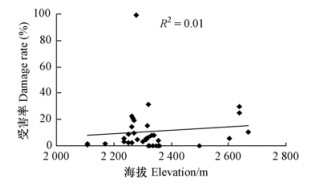
|
图 1 林分受害率与海拔的关系 Fig.1 Relation between stand damage rate and elevation |
图 2表明,林分受害率与土壤厚度紧密相关(R2=0.856),当土壤厚度大于100 cm(含100 cm)时林分受害率非常低;当土壤厚度从100 cm减至80 cm(含80 cm)时受害率随土壤变薄明显升高;在低于80 cm后受害率急剧升高;在土壤厚度为60 cm的26号样地上,受害率高达99%,在分析受害率与其他立地条件因子的关系时,没有利用这个样地,以排除土壤厚度的影响。
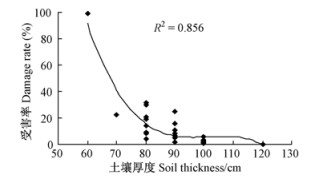
|
图 2 林分受害率与土壤厚度的关系 Fig.2 Relation between stand damage rate and soil thickness |
图 3表明,南坡林分的雪害率最高,高达28%,高于其他坡向。
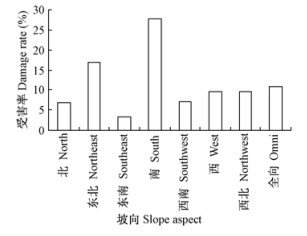
|
图 3 不同坡向的林分受害率 Fig.3 Stand damage rates in different slope aspects |
图 4表明,坡顶、上坡和中坡的受害率变动在16%左右,高于下坡和坡底林分的2%的受害率。
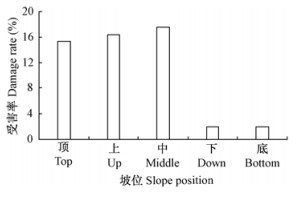
|
图 4 不同坡位的林分受害率 Fig.4 Stand damage rates in different slope positions |
调查样地的坡度变化在0~35°(图 5),存在林分受害率随坡度增大而升高的趋势,但线性相关性并不显著(R2=0.029)。

|
图 5 林分受害率与坡度的关系 Fig.5 Relation between stand damage rate and slope degree |
本研究所调查样地的林龄为13~28年。图 6表明,林分受害率与林龄线性相关性不显著(R2=0.203),林分受害率的林龄差别不大,呈随林龄增加而逐渐降低的微弱趋势(图 6)。这可能与本研究所调查的华北落叶松林样地年龄分布范围较窄有关。
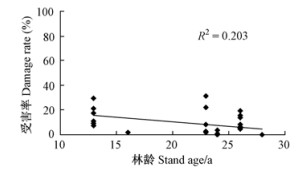
|
图 6 林分受害率与林龄的关系 Fig.6 Relation between stand damage rate and stand age |
表 2表明,林分受害率随密度增大急剧升高,在密度较低时( < 1 500株·hm-2)受害率仅为1.37%;当密度为1 500~3 000株·hm-2时升至7.41%;当密度高于3 000株·hm-2时大幅升至25.76%。方差分析和多重比较结果表明,3种密度的总受害率之间差异显著(P<0.05)。
|
|
图 7是低海拔(2 100~2 300 m)、中海拔(2 300~2 500 m)和高海拔(>2 500 m)3组样地受害率随林分高径比的变化关系。图 7表明低海拔和中海拔林分受害率均随林分高径比增大而升高,尤其当高径比大于0.9时,受害率随高径比增加快速升高;在高海拔段一组,难以看出受害率随高径比的变化规律,这可能与该组样地数据少、土层较薄及正对风口这些因素有关。
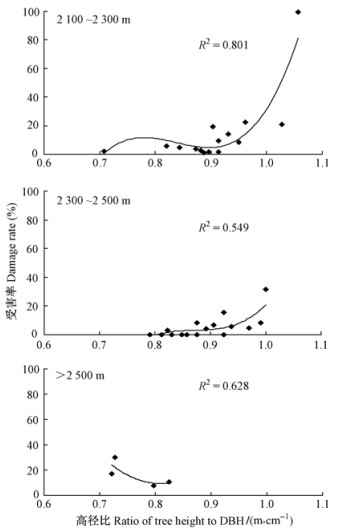
|
图 7 不同海拔组的林分受害率与高径比的关系 Fig.7 Relation between stand damage rates and the ratio of tree height to DBH in three stand groups with different elevation |
图 8是土壤较薄(60~70 cm)、较厚(80~90 cm)和很厚(100~120 cm)3组样地受害率随林分高径比的变化。图 8表明土壤很厚样地的林分受害率非常低,多为0%;土壤较厚样地的受害率在高径比超过0.9后会随高径比增大而明显上升,在高径比为0.8~0.9时保持低稳水平,在高径比为0.7~0.8时可能因受到其他立地条件(高海拔和风口样地)的较大影响,而表现出林木受害率随高径比增大而减小;土层较薄的样地数量很少,却仍表示出受害率随林分高径比增大而增加的趋势。
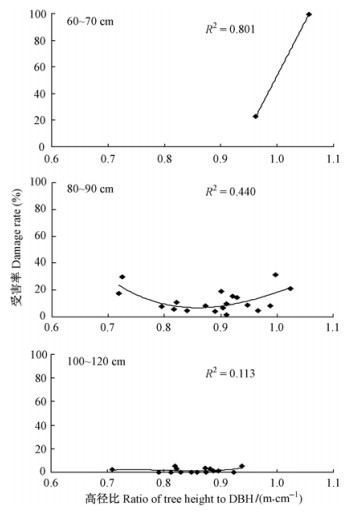
|
图 8 不同土层厚度的林分受害率与高径比的关系 Fig.8 Relation between stand damage rate and the ratio of tree height to DBH in three stand groups with different soil thickness |
考虑到较高木(树高超过样地平均树高的10%)的掘根或折断对其下生长树木的二次伤害可能会干扰林分受害率与高径比关系,所以图 9中仅展示了较高木受害率随林分高径比的变化:当高径比大于0.7后,较高木即出现受害现象,高径比为0.7~0.9时,受害率随高径比升高的变化幅度不大;当高径比大于0.9以后,较高木受害率随高径比增大显著升高;在林分高径比大于1.0后,较高木受害率急剧升高。
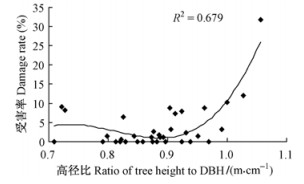
|
图 9 样地较高木受害率与林分高径比的关系 Fig.9 Relation between stand damage rates and the ratio of tree height to DBH in the dominant height |
综合来看,林分高径比大于0.7后,森林会发生雪害,林分高径比大于0.9后,雪害程度显著升高,林分高径比大于1.0后,雪害程度急剧升高。
4 讨论与结论本次六盘山华北落叶松林雪灾受害率表现为土层越薄越严重,这与李秀芬等(2004)在辽东山区调查的天然林受害情况一致。Kenderes等(2007)认为并非所有冰雪灾害与地形(坡向和坡度)都有统计关系,但本研究中阳坡受害率较大,可能与阳坡土层瘠薄有关;Lafon等(1999)和Valinger等(1992)认为,处于山脊或风口等特殊立地的林分易受害,本研究发现高海拔样地的受害率比低海拔样地严重,这可能是高海拔地段雪量大、积雪时间长(Megahan et al., 1987;贺庆棠,2001)、融化缓慢、风大等原因造成的。
相对于立地因子而言,林分结构因子是通过森林经营来减免雪灾的可控因子。Kellomaki等(1999)、Peltola等(1999)和Pellikka等(2003)用树木的胸径与树高的比来评价林木雪害风险,认为比值小的林木易断裂(Petty et al., 1981;Foster et al., 1992;Dobbertin,2002),尤其是比值小于1:90或1:100的林木特别易遭雪灾(Petty et al., 1981;Paatalo et al., 1999)。本研究采用的林分高径比相当于这些研究中所用指标的倒数,但高径比的算法简单、形象,更易被林业工人理解和接受。本研究表明,林分高径比(m/cm)是决定林木雪灾风险的重要因子,当高径比超过0.7后就可能发生雪害,超过0.9后树木受害率快速上升,超过1.0以后则急剧上升,这与Petri等(2003)对芬兰西部雪害的观测结果一致。值得指出的是,在树木高径比过低时因为树冠和枝条过于宽大也可能容易发生雪害,Zhu等(2006)研究表明当高径比为0.5左右时会有掘根现象发生,因本次调查样地较少,没有涉及这样的较低高径比,所以不能进行较低高径比范围的雪害影响评价。
林分密度过高会导致林木竞争加剧(Van Dyke,1999),形成细高树形和较大的高径比,从而容易遭受雪害。因此,通过调整密度调控林分高径比是增强林分抵抗雪害能力的可行途径(Zobel et al., 1989)。通过间伐把林分的高径比降低到0.7左右,可有效减免森林雪灾,如果1次性间伐强度过大、实施困难,也可分2次进行。并在以后的森林经营管理中将林分高径比控制在不超过0.9的范围,否则雪灾危险会急剧增大。此外,适地适树也是预防雪灾的基本措施(Zhu et al., 2003a;2003b),营造乔木林时优先选择土层深厚、坡度平缓的立地和避开山脊风口处,在易遭雪灾的立地优先营造抵抗雪灾能力强的树种或营造灌木等。但更加详细系统的造林营林减灾措施及其减灾效果,以及投入-产出关系的分析,还待进一步研究。
| [] | 贺庆棠. 2001. 中国森林气象学. 北京, 中国林业出版社. |
| [] | 李秀芬, 朱教君, 王庆礼, 等. 2004. 辽东山区天然次生林雪/风灾害成因及分析. 应用生态学报, 6(15): 941–946. |
| [] | 李秀芬, 朱教君, 王庆礼, 等. 2005. 森林的风/雪灾害研究综述. 生态学报, 25(1): 149–154. |
| [] | 沈国舫. 2008. 关注重大雨雪冰冻灾害对我国林业的影响—主编的话. 林业科学, 44(3): 1. DOI:10.11707/j.1001-7488.20080301 |
| [] | Boerner R E J, Runge S D, Kooser J G. 1988. Localized ice storm damage in an Appalachian plateau watershed. American Midland Naturalist, 119(1): 199–208. DOI:10.2307/2426069 |
| [] | Braastad H. 1978. Report of snow and wind damage on a thinng experiment area. Norsk Institutt for Skogforskning Rep, 78(1): 49–54. |
| [] | Bragg D C, Shelton M G, Zeide B. 2003. Impacts and management implications of ice storms on forests in the southern United States. Forest Ecology and Management, 186(12): 99–123. |
| [] | Dale V H, Joyce L A, Mcnulty S, et al. 2001. Climate change and forest disturbances. BioScience, 51(9): 723–734. DOI:10.1641/0006-3568(2001)051[0723:CCAFD]2.0.CO;2 |
| [] | Dobbertin M. 2002. Influence of stand structure and site factors on wind damage comparing the storms Vivian and Lothar. Forest Snow Landscape Research, 77(1/2): 187–204. |
| [] | Foster D R, Boose E M. 1992. Patterns of forest damage resulting from catastrophic wind in central New England. Journal of Ecology, 80(1): 79–98. DOI:10.2307/2261065 |
| [] | Gardiner B A, Suárez E, Quine C P. 2003. Development of a GIS based wind risk system for British forestry. Karlsruhe: Lab Building, Environment Aerodynam ics, Institute of Hydrology, University of Karlsruhe, Germany: 145–150. |
| [] | Kellomaki S, Ikonen, Peltola H, et al. 1999. Modelling the structural growth of Scots pine with implications for wood quality. Ecological Modelling, 112(2): 117–134. |
| [] | Kenderes K, Aszalos R, Ruff J. 2007. Effects of topography and tree stand characteristics on susceptibility of forests to natural disturbances (ice and wind) in the BÖrzsÖny Mountains (Hungary). Community Ecology, 8(4): 209–220. |
| [] | Lafon C W, Graybeal D Y, Orvis K H. 1999. Patterns of ice accumulation and forest disturbance during two ice storms in southwestern Virginia. Physical Geography, 20(3): 97–115. |
| [] | Megahan W F, Steele R. 1987. An approach for predicting snow damage to ponderosa pine plantations. Forest Science, 32(2): 485–503. |
| [] | Nykanen M L, Peltola H, Quine C. 1998. Factors affecting snow damage of trees with particula reference to European conditions. Silva Fennica, 31(2): 193–213. |
| [] | Paatalo M, Peltola H. 1999. Modelling the risk of snow damage to forests under short term snow loading. Forest Ecology and Management, 116(1): 51–70. |
| [] | Pellikka P, Järvenpää E. 2003. Forest stand characteristics and wind and snow induced forest damage in boreal forest. International Conference 'Wind Effects on Trees', 8(1): 269–276. |
| [] | Peltola H, Kellom K. 1997. Model computations on the critical combination of snow loading and wind speed for snow damage of Scotspine, Norway spruce and Birth sp. at stand edge. Forest Ecology and Management, 95(3): 229–241. DOI:10.1016/S0378-1127(97)00037-6 |
| [] | Peltola H, Kellom K, Hassinen A. 2000. Mechanical stability of Scots pine, Norway spruce and birth: an analysis of tree-pulling experiments in Finland. Forest Ecology and Management, 135(1): 143–153. |
| [] | Petri P, Elise J. 2003. Forest stand characteristics and wind and snow induced forest damage in boreal forest//Ruck B, Kottmeier C. Proceedings of the international conference wind effects on tree. Karlsruhe: Lab Building, Environment Aerodynamics, Institute of Hydrology, University of Karlsruhe, Germany, 269-276. |
| [] | Petty J A, Worrell R. 1981. Stability of coniferous tree stems in relation to damage by snow. Forestry, 54(2): 115–128. DOI:10.1093/forestry/54.2.115 |
| [] | Quine C P. 1995. Assessing the risk of wind damage to forests: practice and pitfalls. Cambridge: Cambridge University Press: 379–403. |
| [] | Schubert G H. 1971. Growth response of even-aged ponderosa pines related to stand density levels. Journal of Forestry, 69(12): 857–869. |
| [] | Smith W H. 2000. Ice and forest health. Northern Journal of Applied Forestry, 17(1): 16–19. |
| [] | Solantie R. 1994. Effect of weather and climatological background on snow damage of forests in southern Finland in November 1991. Silva Fennica, 28(3): 203–211. |
| [] | Valinger E, Lundqvist L. 1992. The influence of thinning and nitrogen fertilization on the frequency of snow and wind induced stand damage in forests. Scottish Forestry, 46(4): 311–320. |
| [] | Valinger E, Lundqvist L, Bondesson L. 1993. Assessing the risk of snow and wind damage from tree physical characteristics. Forestry, 66(3): 249–260. DOI:10.1093/forestry/66.3.249 |
| [] | Van Dyke O. 1999. A literature review of ice storm impacts on forests in Eastern North America. Ontario Ministry of Natural Resources Southcentral Sciences Section, 4(1): 1–29. |
| [] | Zhu J J, Li X F, Liu Z G. 2006. Factors affecting the snow and wind induced damage of a montane secondary forest in northeastern China. Silva Fennica, 40(1): 37–51. |
| [] | Zhu J J, Matsuzaki T, Li F Q. 2003a. Effect of gap size created by thinning on seedling emergency, survival and establishment in a coastal pine forest. Forest Ecology and Management, 182(3): 339–354. |
| [] | Zhu J J, Li F Q, Matsuzaki T. 2003b. Effects of thinning on wind damage in Pinus thunbergii plantation-based on theoretical derivation of risk ratios for assessing wind damage. Journal of Forestry Research, 14(1): 1–8. DOI:10.1007/BF02856755 |
| [] | Zobel B J, Van Buijtenen J P. 1989. Wood variation: its causes and control. Springer Verlag: Berlin: 276–313. |
 2012, Vol. 47
2012, Vol. 47



